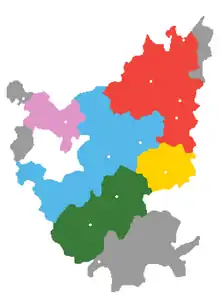New Xiang
New Xiang, also known as Chang-Yi (长益片 / 長益片) is the dominant form of Xiang Chinese. It is spoken in northeastern areas of Hunan adjacent to areas where Southwestern Mandarin and Gan are spoken. Under their influence, it has lost some of the conservative phonological characteristics that distinguish Old Xiang. While most linguists follow Yuan Jiahua in describing New Xiang as a subgroup of Xiang Chinese,[1] Zhou Zhenhe and You Rujie classify it as Southwestern Mandarin.[2][3] However, New Xiang is still very difficult for Mandarin speakers to understand, particularly the old style of New Xiang.
| New Xiang | |
|---|---|
| Chang-Yi | |
| Native to | People's Republic of China |
| Region | Hunan |
| Language codes | |
| ISO 639-3 | None (mis) |
| ISO 639-6 | cayi |
| Glottolog | chan1316 |
| Linguasphere | 79-AAA-eaa |
 New Xiang is in red. It is in contact with Southwestern Mandarin to the northwest, Gan to the east, Old Xiang to the west, and Hengzhou Xiang to the south (yellow). | |
Dialects and Regions
New Xiang-speaking cities and counties are mainly located in the northeast part of Hunan, the lower river of Xiang and Zi. The Changsha dialect is representative. There are three main subdialects under New Xiang.
- Chang-Tan
- Urban Changsha, Changsha County, Wangcheng District, Ningxiang, Liuyang*, Xiangyin, Miluo, Nanxian, Urban Zhuzhou, Zhuzhou County, Urban Xiangtan, Xiangtan County, Nanxian
- Yi-Yuan
- Urban Yiyang, Yuanjiang, Taojiang
- Yueyang
- Yueyang County, Yueyang
Suantang 酸汤 is a lect spoken by about 80,000 ethnic Miao people in Baibu 白布, Dihu 地湖, Dabaozi 大堡子, and Sanqiao 三锹 in Tianzhu, Huitong, and Jing counties of Hunan province (Chen Qiguang 2013:35).[4] It is very similar to New Xiang, but is unintelligible with Southwestern Mandarin.
References
- Norman, Jerry (1988). Chinese. Cambridge University Press. p. 207. ISBN 978-0-521-29653-3.
- Zhou, Zhenhe; You, Rujie (1986). Fāngyán yǔ zhōngguó wénhuà 方言与中国文化 [Dialects and Chinese culture]. Shanghai Renmin Chubanshe.
- Kurpaska, Maria (2010). Chinese Language(s): A Look Through the Prism of "The Great Dictionary of Modern Chinese Dialects". Walter de Gruyter. p. 55. ISBN 978-3-11-021914-2.
- Chen, Qiguang [陈其光] (2013). Miao and Yao language [苗瑶语文]. Beijing: China Minzu University Press.